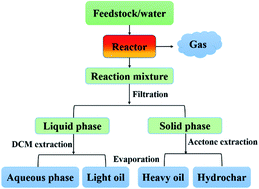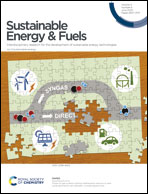Conversion of high-ash microalgae through hydrothermal liquefaction†
Abstract
Natural microalgae (NM, Scenedesmus) cultivated by utilization of exhaust gas from a municipal solid waste combustion power plant were used for the biofuel production through hydrothermal liquefaction (HTL). The high-ash NM underwent acid-washing to obtain deashing microalgae (DA). HTL experiments were carried out at different temperatures from 260 °C to 340 °C with NM and DA. Products derived from NM and DA were examined by various techniques in order to identify the influence of the ash on the hydrothermal decomposition behavior. The results show that the ash inhibits the transformation of microalgae. The bio-oil yield including heavy oil and light oil is in the range of 17.59–22.09% for NM and 24.30–31.14% for DA, respectively. Calcium carbonate in the ash promotes deamination, resulting in an increase in the relative content of ketones in the NM-derived light oil. The concentration of NH4+ in the aqueous phase derived from NM is in the range of 1373–1860 mg L−1, and PO43− is undetected due to the precipitation reaction between phosphorus and calcium ions. The HHV values of NM-derived hydrochars are low, ranging from 8.83 MJ kg−1 to 9.88 MJ kg−1, compared with those of DA-derived hydrochars,. For natural microalgae, the deashing pretreatment before HTL is of great significance for improving the biocrude yield and quality, as well as the biomass conversion efficiency, nitrogen utilization and the hydrochar quality.



 Please wait while we load your content...
Please wait while we load your content...